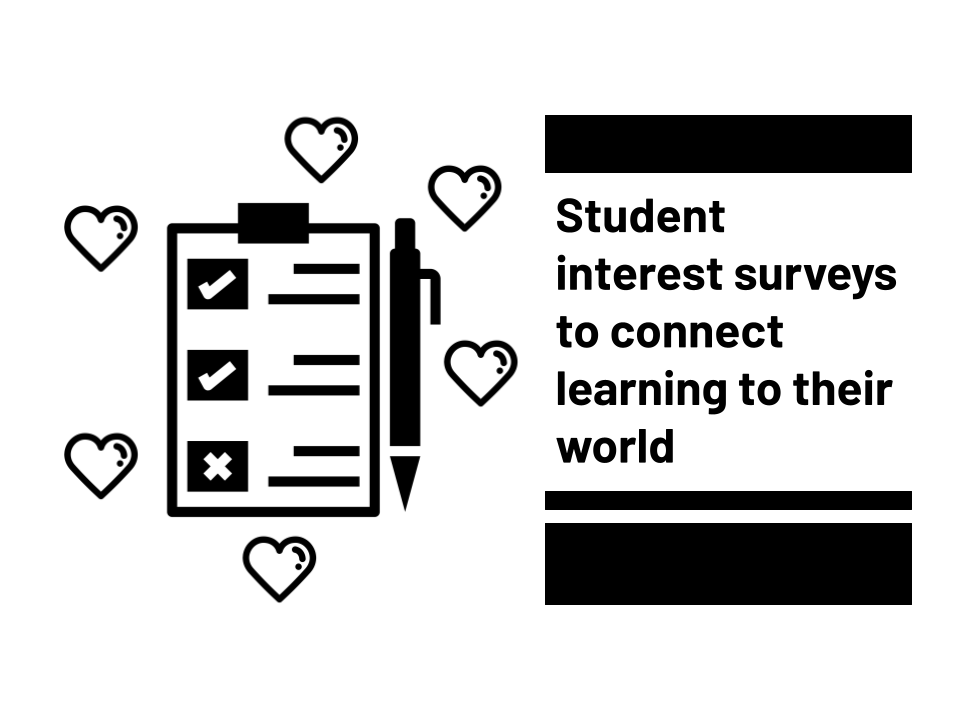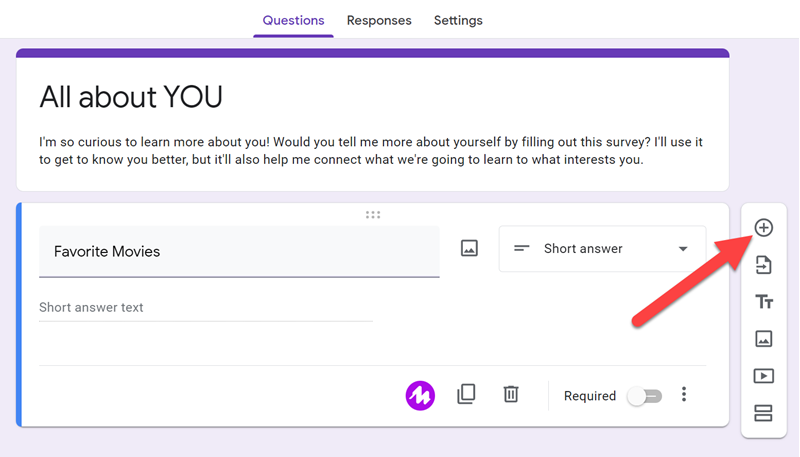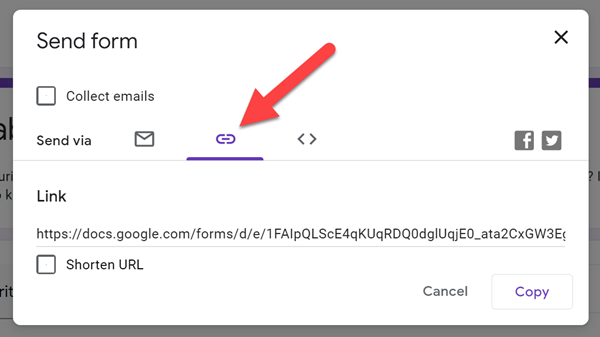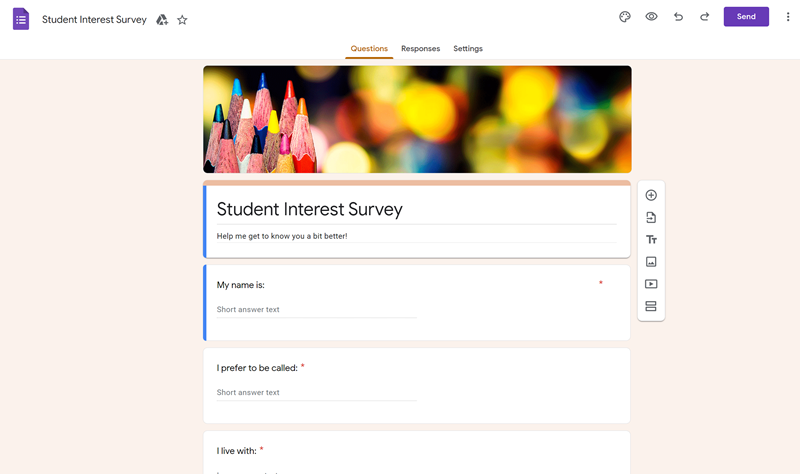
Student interest surveys help us know what makes our students tick, which helps us build relationships and learning that matters.
When we know what makes students tick, it can help us create learning that they'll really love.
But that's not the only reason to get to know our students' interests.
When we know them and what they're into -- their passions, their hobbies, their curiosities, and more -- we build a level of trust. Trust leads to influence. It also builds rapport and motivation to succeed in our classes.
The top three rules of teaching: relationships, relationships, relationships.
So, how do we find out what students are into?
There are lots of answers to that question. But there's one that I LOVE because it its simplicity and reviewability later.
Student interest surveys.
Want to know what students are into? Ask them!
And when they tell you, remember it -- and refer to it when planning learning and when interacting with them.
3 reasons why student interest surveys level up learning
Can knowing more about your students' interests really help their learning?
Absolutely. Here are a few reasons why.
1. Knowing students' interests builds trust.
Many of us got into education because we want to make a difference. We want to influence our students' lives. That might mean simply encouraging them to complete assignments. It might mean encouraging them to be the best they can be in life.
Gaining students' trust is the first and most foundational step. Trying to encourage, convince, or persuade them to do something without that trust can be futile.
"Before people will change, they have to be willing to listen," writes Jonah Berger in The Catalyst: How to Change Anyone's Mind. "They have to trust the person they're communicating with. And, until that happens, no amount of persuasion is going to work."
2. Knowing students' interests makes learning relevant.
When you know what students value -- what's important to them -- you better understand their value system and what drives their decisions. Depending on students' backgrounds, their family situations, and their life experiences, those values might vary significantly. Teaching that is relevant and responsive to students' lives and culture helps you align with students and know which direction to go, writes Zaretta Hammond in Culturally Responsive Teaching and the Brain.
3. Knowing students' interests helps you make connections.
Understanding what interests students helps you connect what they're learning to their own lives. For one, it helps you make analogies. Compare relationships and concepts they understand in their lives to new content. Show how they're similar or different. That helps tether new ideas to something they already understand deeply. It also helps create more relevant examples.
How to create a student interest survey in Google Forms
One of the easiest ways I've found to create surveys like these is in Google Forms. (If you're at a Microsoft school, Microsoft Forms will do the trick, too.) Create the questions you'd like to ask in a Google Form. Share the survey with students. Look over their responses in the responses tab of the form or in a spreadsheet.
1. Create the Google Form and add questions to it. Find Google Forms in Google Drive (click the "New" button and choose "More" to find it) or by typing forms.new into a web browser. Write your questions -- or categories of information you're looking for -- and select "short answer" so students can type their responses. Use the plus button to add new questions.

2. Share the survey with your students. When you've added all the questions you want, share the survey with students. Click the "Send" button in the top right. You can email it to students or embed it in a class website. But my favorite way is just to copy the link and post it in Google Classroom or your learning management system.

3. Review their results. When your students are done taking the survey, you can look over their responses by clicking the Responses tab. You can scroll through the individual responses. Or you can click the green spreadsheet button to create a spreadsheet linked to the form's responses. You'll be able to view that spreadsheet -- and even share it with students if you want them to see each other's responses.

BONUS: Print out a Google Forms survey! If students are absent or if they don't have access to tech, a printed survey can be just as effective. Plus, you can hang on to the hard copies with their responses to refer to later. Google Forms helps you create printable surveys in just a few clicks. Check out the video below!
TEMPLATE: Make a copy of this student interest survey
Want to get started but don't have time to create your own survey? No problem! Make a copy of this Google Forms template. Once you make a copy, you can edit and adjust it however you'd like before sharing it with students.
Questions to include in a student interest survey
What do you ask students about? Well, quite simply, whatever you want!
But be careful. Have a reason for what you ask. Gathering a bunch of information about them and never using them might actually send a message that you're not really paying attention. Plus, use discretion. Don't ask questions that'll make students uncomfortable, that brings up trauma, or that invades their privacy.
Ask yourself what might be helpful to know about going forward that can inform the relationship you build with them and the teaching and learning you design for them. Here are some possibilities:
- Media (movies, TV shows, YouTube channels, podcasts, etc.)
- School activities (sports, the arts, clubs, etc.)
- Non-school activities (organizations, clubs, or events outside of school)
- Family traditions (informal ones like favorite activities to do together ... or formal ones like holidays they celebrate)
- Foods (meals, sweets, drinks, etc.)
- Social media they use (TikTok, Snapchat, Instagram, etc.)
- Classroom preferences (what they love -- and dislike -- when it comes to learning)
- Personal preferences (name they prefer to be called)
- Things they want to make sure you know about them (you wouldn't want to share this in a spreadsheet to the class)
- Reading material (books, magazines, blogs, etc.)
- Future aspirations (job, location, etc.)
That list just scratches the surface! You know your students -- or, you're about to anyway! Pick questions that you think are appropriate that will give you the kind of information you think you'll need.
What to do with student interest survey results
Once your students have taken the surveys, what should you do?
Something! You should do something with them, for sure. As stated earlier, asking them about themselves and then not using or remembering their responses might send the message that you're not paying attention or you don't care.
Here are some ideas to help make connections with students, building relationships and trust:
1. Connect student interests to content you're teaching. As mentioned earlier, knowing what your class loves in general can help you explain things in terms of their interests. Compare historical characters to characters in movies, for example. Explain relationships in light of a relationship from their favorite TV shows.
2. Build activities that feel like student interests. If students are into social media, create an activity that makes it feel like they're posting on social media to show what they know. These social media-inspired templates can get you started right away. Create fictitious conversations between characters in students' favorite movies and characters you've learned about. Phrase practice questions through the lens of things students love.
3. Check in with students. Ask them how they're doing. How their personal life is going. How things at home are going. How their other classes are going. Use discretion, of course, and do what feels appropriate. The information you collect in the student interest survey gives you a glimpse into their lives. That's a starting point. Build the relationship by continually connecting.
4. Celebrate their accomplishments. When you learn about their hobbies, their activities, their clubs and teams, etc., pay attention to what's happening. If they have a great game, cheer them along -- and consider going to a game to watch! If they don't reach their ambitions, stand next to them and encourage them for the next time.
The real reason we learn about our students' interests
Why are we doing all of this again?
Sure, it is building a foundation -- of trust, of mutual respect, of a relationship. That foundation will pay dividends when trust is built. When students know they can trust you, your words will carry more weight in their lives. That certainly goes for classwork, for helping to motivate them to learn, for completing assignments and trying their best.
But more importantly than that, the foundation of trust builds your influence to help them become a better person, to do their best, to see how bright their future is.
In short, that trust helps you do what so many of us got into education for.
It helps you make a difference.
Have you used student interest surveys before? In a comment below, tell us about them, the kinds of questions you asked, and what you did with the information!
What other ways do you build relationships with your students to create that foundation of trust? Tell us that in a comment, too!
For notifications of new Ditch That Textbook content and helpful links:
Are you looking for quality, meaningful professional learning that both equips and inspires teachers?
Matt provides in-person and virtual keynotes, workshops and breakout sessions that equip, inspire and encourage teachers to create change in their classrooms. Teachers leave with loads of resources. They participate. They laugh. They see tech use and teaching in a new light. Click the link below to contact us and learn how you can bring Matt to your school or district!
Is Matt presenting near you soon? Check out his upcoming live events!




I have used a similar survey in order to be able to match students with an Epal from another country who they would be communicating with throughout the year. Previously I would randomly assign students but this way I have found that the pairs of students build up a better rapport and this has led to students that have left school , returned to visit and tell me that they are still in contact with their Epal from the project years before !
The added bonus is that I get to know the learners better at the beginning of the year too and can adapt some of my material to their specific interests too.